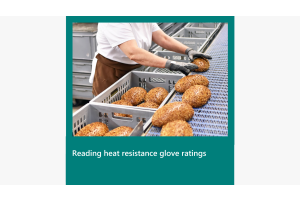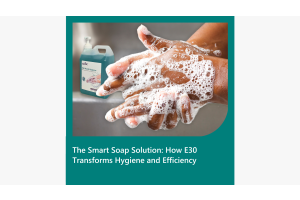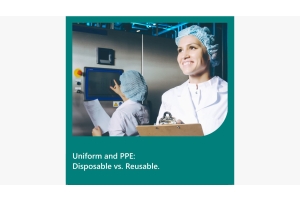Blog
-
May 30, 2023
In the food industry, safety is paramount, and hand protection is no exception. Cut-resistant gloves are a critical component in ensuring worker safety. But with so many ratings and standards out there, it can become confusing to navigate and understand them all. In this blog post, we aim to simplify and explain the different cut ratings and standards, both old and new, that dictate the level of protection offered by cut-resistant gloves.
Understanding Cut Ratings and Standards
Before diving into specifics, it's essential to understand what cut ratings are and why they matter. In simple terms, cut ratings indicate the level of cut resistance offered by a glove. Higher cut ratings mean that the gloves offer better protection against cuts. These ratings are standardized by various bodies, each with different testing methods and rating systems.
1. EN388 (European Standard)The EN388 standard is a popular and widely
-
April 26, 2023
Could your waste be of value?
Efficiency and time are crucial factors for the success of any production site, to meet efficiency standards while reducing environmental impact. Although waste is an inevitable by-product of production, utilizing coloured bin liners allows for more efficient management and disposal of waste.
How can coloured bin liners help?
Colour coding has proven successful throughout the industry, as its quick visual recognition allows employees to speedily distinguish between ingredients. This prevents any potential health hazards such as cross-contamination. Coloured bin liners could be utilised in this same way. For example, to segregate ingredients that can be reused, recycled, composted, or that are potentially harmful.
-
March 23, 2023
A food processing plant has one of the highest responsibilities to maintain hygiene standards, which promotes the need for both spontaneous and deep, regular cleaning. Wipes are part of both these processes and are indispensable to the food processing industry.
How do I get the full benefit out of my wipes? It is first important to consider what situation your wipes are used in. Considering the machinery, surfaces, chemicals, and ingredients will clarify which spec suits your needs.
Material composition and absorbency
A wipe is made from a combination of synthetic fibres and either paper or viscose. The synthetic fibres give the wipe strength and allow the wipe to hold its shape, whereas the paper or viscose (wood pulp turned into fabric) increases the absorbency. Therefore,
-
March 13, 2023
In the food processing industry, choosing the right type of glove can be a challenging decision, as it is one of the most critical food processing consumables. Often However, the length of the cuff is a forgotten consideration. Explore the differences between long cuff and short cuff gloves and help you determine which one is right for your food processing needs.
Short cuff gloves, or standard cuffs, are typically 240mm (from cuff to tip of middle finger) and normally extend to the wrist.
Long cuff nitrile gloves are typically 280-300mm long (from cuff to tip of middle finger). Extending past the wrist.
Extra-long cuff are also available, ranging from 400mm and even up to 600mm. These gloves can extend up the arm, often up to the elbow or even higher.Which One is Right for You?
Disposable gloves are used in such a vast array of circumstances, across many industries.
There are many subtle differences in gloves,
-
February 23, 2023
In the food processing industry, workers are often exposed to various work environments that require different types of personal protective equipment (PPE) to maintain hygiene standards. Among the body parts most susceptible to harm are the hands, which are prone to burns, cuts, and exposure to harmful chemicals.
To facilitate easier hand insertion, a grey-coloured coating is applied on the inside of rubber latex gloves. So-called silver lined gloves are generally thicker and offer better resistance to chemical and abrasive hazards than disposable nitrile gloves, making them a good choice for tasks that require heavy-duty protection. They also have better temperature resistance than disposable gloves.
Although silverlined latex gloves are an excellent option for protecting against these risks, a small percentage (less than 1%) of individuals may experience allergic reactions.
-
February 10, 2023
In the food processing industry, colour coding is an effective way to prevent cross-contamination and reduce the risk of allergen exposure.
Designating a specific colour to different ingredients or parts of the process allows employees to identify and maintain food safety standards quickly.When deciding which colours to use, it's important to start by identifying which ingredients require segregation. For example, if you have allergens such as nuts or gluten in your food processing site, it's important to consider the colour
-
January 16, 2023
Why is biodegradability so important?
Biodegradability is a crucial aspect to consider when it comes to protecting our environment and reducing the amount of plastic waste that ends up in landfills. Biodegradable plastics break down into natural substances like water, carbon dioxide, and biomass, rather than persist in the environment like traditional plastics. This helps to reduce plastic pollution and its negative impact on ecosystems and wildlife.
It is important to note the difference between oxo-degradable and genuine biodegradability. Oxo-degradable plastics contain additives that cause them to break down when exposed to certain environmental conditions, such as heat and UV light, but they do not break down into natural substances and can persist in the environment for a long time.
Although disposable gloves are essential for maintaining food safety and preventing the spread of germs and bacteria, the number of gloves used and discarded is substantial, and
-
October 04, 2022
Metal detectable products are becoming increasingly common within the food industry, It is essential to understand the different features and how they can impact you. As always, the priority is ensuring the highest standards of safety are maintained. Pen features vary significantly, so choosing the right pen to suit your needs is essential.
Here are some factors you need to consider when selecting your metal detectable stationery.
Is the most detectable pen the best option?
While it may sound counterintuitive, the pen made from the most detectable plastic might not be the best option. Small amounts of ferrous material are added to the plastic mix to make plastic detectable. Simply put, the higher the ferrous material in the mix, the more detectable the plastic is. However, this both makes the
-
September 12, 2022
PPE and Hygiene are indispensable in the food processing industry. The purpose of hygiene wear and PPE are quite different to one another; hygiene wear is disposable clothing designed to keep the food free from contamination; protecting the task from the wearer whereas PPE protects the wearer from the task. These products can occasionally satisfy both purposes. For instance, a disposable poncho protects the wearer from splashes while preventing matter from falling off their clothes.
Colour, as we know, plays a critical role in preventing cross-contamination and controlling allergens. Most hygiene wear is available in blue and or white, but many come in additional colours such as red, yellow, and green. Purple, pink, orange and black are unique colours and can further signify different roles or tasks.
It is crucial, however, not to overcomplicate your colour-coded system. Colour coding works due to its quick visual recognition and ease of interpretation - particularly
-
August 15, 2022
Hygiene wear is available in many forms within the food processing industry. Keeping the food pure and uncontaminated is of utmost importance. Labcoats are an indispensable product to ensure food is protected.
Labcoats act as a hygiene barrier between clothing and the task at hand. Many food production sites mandate labcoats. However, it’s hard to know which is preferable, disposable, or reusable. While both have advantages, the primary purpose is the same. It comes down to whether you prefer to purchase a uniform for your team members and are willing to launder it or choose to have disposable lab coats which cover your team’s usual clothes.
With disposable wear, don’t forget to purchase larger sizing to account for regular clothing underneath. Labcoats are designed to be efficiently made, so shaping is limited, this means bigger sizes can be comfortably worn.
The primary purpose





